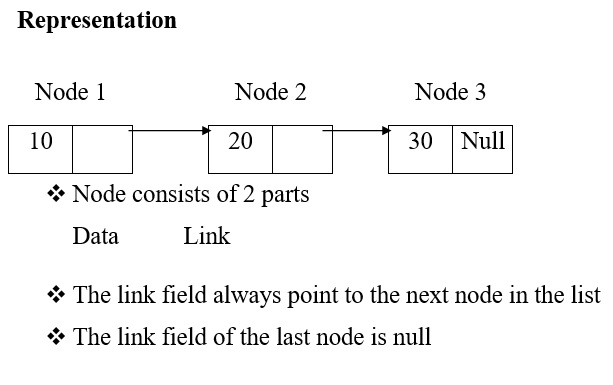
 Data Structure
Data Structure Networking
Networking RDBMS
RDBMS Operating System
Operating System Java
Java MS Excel
MS Excel iOS
iOS HTML
HTML CSS
CSS Android
Android Python
Python C Programming
C Programming C++
C++ C#
C# MongoDB
MongoDB MySQL
MySQL Javascript
Javascript PHP
PHP
- Selected Reading
- UPSC IAS Exams Notes
- Developer's Best Practices
- Questions and Answers
- Effective Resume Writing
- HR Interview Questions
- Computer Glossary
- Who is Who
C program to display numbers in reverse order using single linked list
Linked lists use dynamic memory allocation and are collection of nodes.
Nodes have two parts which are data and link.
Types of Linked Lists
The types of linked lists in C programming language are as follows −
- Single / Singly linked lists
- Double / Doubly linked lists
- Circular single linked list
- Circular double linked list
Single linked list
The diagram given below depicts the representation of single linked list.

Example
Following is the C program to display the numbers in reverse order by using the single linked list −
#include <stdio.h>
#include <stdlib.h>
struct node {
int num;
struct node *nextptr;
}*stnode;
void createNodeList(int n);
void reverseDispList();
void displayList();
int main(){
int n;
printf("
single Linked List : print it in reverse order :
");
printf("------------------------------------------------------------------------------
");
printf(" Input the number of nodes : ");
scanf("%d", &n);
createNodeList(n);
printf("
Data entered in the list are :
");
displayList();
reverseDispList();
printf("
The list in reverse are :
");
displayList();
return 0;
}
void createNodeList(int n){
struct node *fnNode, *tmp;
int num, i;
stnode = (struct node *)malloc(sizeof(struct node));
if(stnode == NULL) {
printf(" Memory can not be allocated.");
}
else{
// reads data for the node through keyboard
printf(" Input data for node 1 : ");
scanf("%d", &num);
stnode-> num = num;
stnode-> nextptr = NULL;
tmp = stnode;
//Creates n nodes and adds to linked list
for(i=2; i<=n; i++){
fnNode = (struct node *)malloc(sizeof(struct node));
if(fnNode == NULL) {
printf(" Memory can not be allocated.");
break;
}
else{
printf(" Input data for node %d : ", i);
scanf(" %d", &num);
fnNode->num = num;
fnNode->nextptr = NULL;
tmp->nextptr = fnNode;
tmp = tmp->nextptr;
}
}
}
}
void reverseDispList(){
struct node *prevNode, *curNode;
if(stnode != NULL){
prevNode = stnode;
curNode = stnode->nextptr;
stnode = stnode->nextptr;
prevNode->nextptr = NULL; //convert the first node as last
while(stnode != NULL){
stnode = stnode->nextptr;
curNode->nextptr = prevNode;
prevNode = curNode;
curNode = stnode;
}
stnode = prevNode; //convert the last node as head
}
}
void displayList(){
struct node *tmp;
if(stnode == NULL){
printf(" No data found in the list.");
}
else{
tmp = stnode;
while(tmp != NULL){
printf(" Data = %d
", tmp->num);
tmp = tmp->nextptr;
}
}
}
Output
When the above program is executed, it produces the following result −
Single Linked List : print it in reverse order : ------------------------------------------------------------------------------ Input the number of nodes : 5 Input data for node 1 : 12 Input data for node 2 : 45 Input data for node 3 : 11 Input data for node 4 : 9 Input data for node 5 : 10 Data entered in the list are : Data = 12 Data = 45 Data = 11 Data = 9 Data = 10 The list in reverse are : Data = 10 Data = 9 Data = 11 Data = 45 Data = 12

Advertisements
